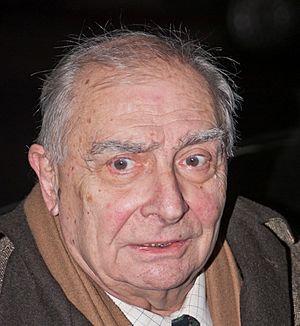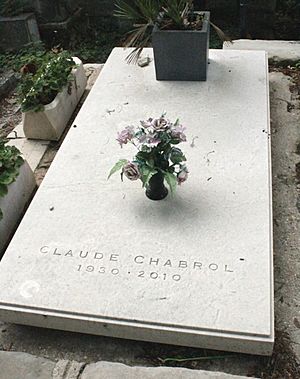Claude Chabrol facts for kids
Claude Henri Jean Chabrol (born June 24, 1930 – died September 12, 2010) was a famous French film director. He was an important part of the French New Wave (nouvelle vague) movement. This group of filmmakers became well-known in the late 1950s. Like his friends and fellow directors Jean-Luc Godard, François Truffaut, Éric Rohmer, and Jacques Rivette, Chabrol first worked as a critic. He wrote for a well-known film magazine called Cahiers du cinéma before he started making his own movies.
Early Life and Love for Film
Claude Chabrol was born in Paris, France, on June 24, 1930. He grew up in a small village called Sardent, far from Paris. Chabrol always felt like a country person. His father and grandfather were pharmacists, and people expected Claude to follow in their footsteps. But when he was a child, he fell in love with movies.
Between the ages of 12 and 14, he even ran a film club in a barn in Sardent. This is when he became very interested in thriller movies and detective stories.
After World War II, Chabrol moved to Paris. He studied pharmacology and literature at the Sorbonne. While in Paris, Chabrol joined film clubs. He often visited the Cinémathèque Française. There, he met Éric Rohmer, Jacques Rivette, Jean-Luc Godard, and François Truffaut. These friends would all become famous directors and writers for Cahiers du Cinéma.
After college, Chabrol served in the French army. He said he worked as a film projectionist during this time. After the army, he joined his friends as a writer for Cahiers du Cinéma. They challenged how French films were made back then. They also supported the idea of Auteur theory. This theory says that the director is the main author of a film.
In 1957, Chabrol and Éric Rohmer wrote a book together. It was about the films of director Alfred Hitchcock. Chabrol had even interviewed Hitchcock with François Truffaut in 1954.
Film Career Begins
Chabrol's movie career started with Le Beau Serge (1958). He filmed it in his hometown of Sardent. He used a small crew and actors who were not very famous. The film cost about $85,000 to make.
Le Beau Serge starred Jean-Claude Brialy and Gérard Blain. It tells the story of two childhood friends who meet again. This film is seen as the first movie of the French New Wave movement. This movement changed French cinema between 1959 and 1962. Chabrol was the first of his friends to finish a full-length movie.
Le Beau Serge was praised by critics and did well at the box office. It won the Grand Prix at the Locarno Film Festival. Chabrol quickly followed this success with Les Cousins in 1958. This film also did very well in France. It won the Golden Bear award at the 9th Berlin International Film Festival.
After these successes, Chabrol started his own film company. It was called AJYM Productions. He used this company to help fund many films made by his friends.
Thrillers became a special kind of movie for Chabrol. He was one of the most active directors of the New Wave. He made almost one film every year from 1958 until he passed away. His early films were often experimental, like other New Wave movies. Later, he also made more commercial films.
In the 1980s and 1990s, Chabrol worked on many projects. He made films for both TV and the big screen. His films Poulet au vinaigre (1985) and Masques (1987) were shown at major film festivals. Madame Bovary (1991) was nominated for a Golden Globe Award for Best Foreign Language Film.
La Cérémonie (1995) is one of his most famous films from this time. It was nominated for many César Awards. His 1999 film The Color of Lies was shown at the 49th Berlin International Film Festival.
In 1995, Chabrol received the Prix René Clair award. This award from the Académie française honored all his work. Chabrol continued to direct films and TV shows into the 2000s.
Personal Life
Claude Chabrol was married three times. His first marriage was to Agnès Goute. They had a son named Matthieu Chabrol. Matthieu later became a composer and wrote music for many of his father's films. Claude then married actress Stéphane Audran. They had a son named Thomas Chabrol, who became an actor. His third wife was Aurore Paquiss. Claude Chabrol had four children in total.
Chabrol was known for being a great cook. He even filmed one of his movies, 10 Days Wonder, in Alsace just so he could visit its restaurants. He said that while Alfred Hitchcock influenced his work, other directors influenced him even more. He named F. W. Murnau, Ernst Lubitsch, and Fritz Lang as his three biggest influences.
Claude Chabrol passed away on September 12, 2010, from leukemia. He is buried in Pere Lachaise Cemetery in Paris.
See also
 In Spanish: Claude Chabrol para niños
In Spanish: Claude Chabrol para niños



